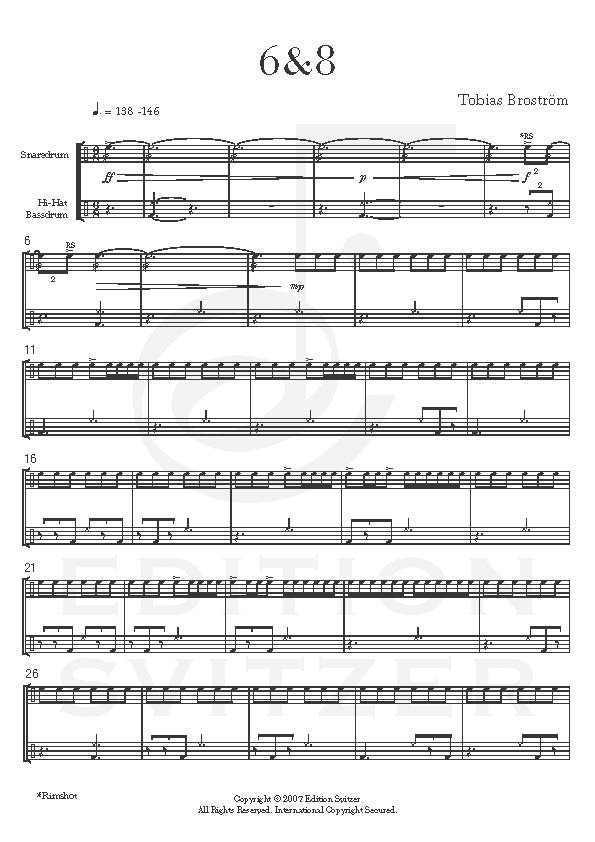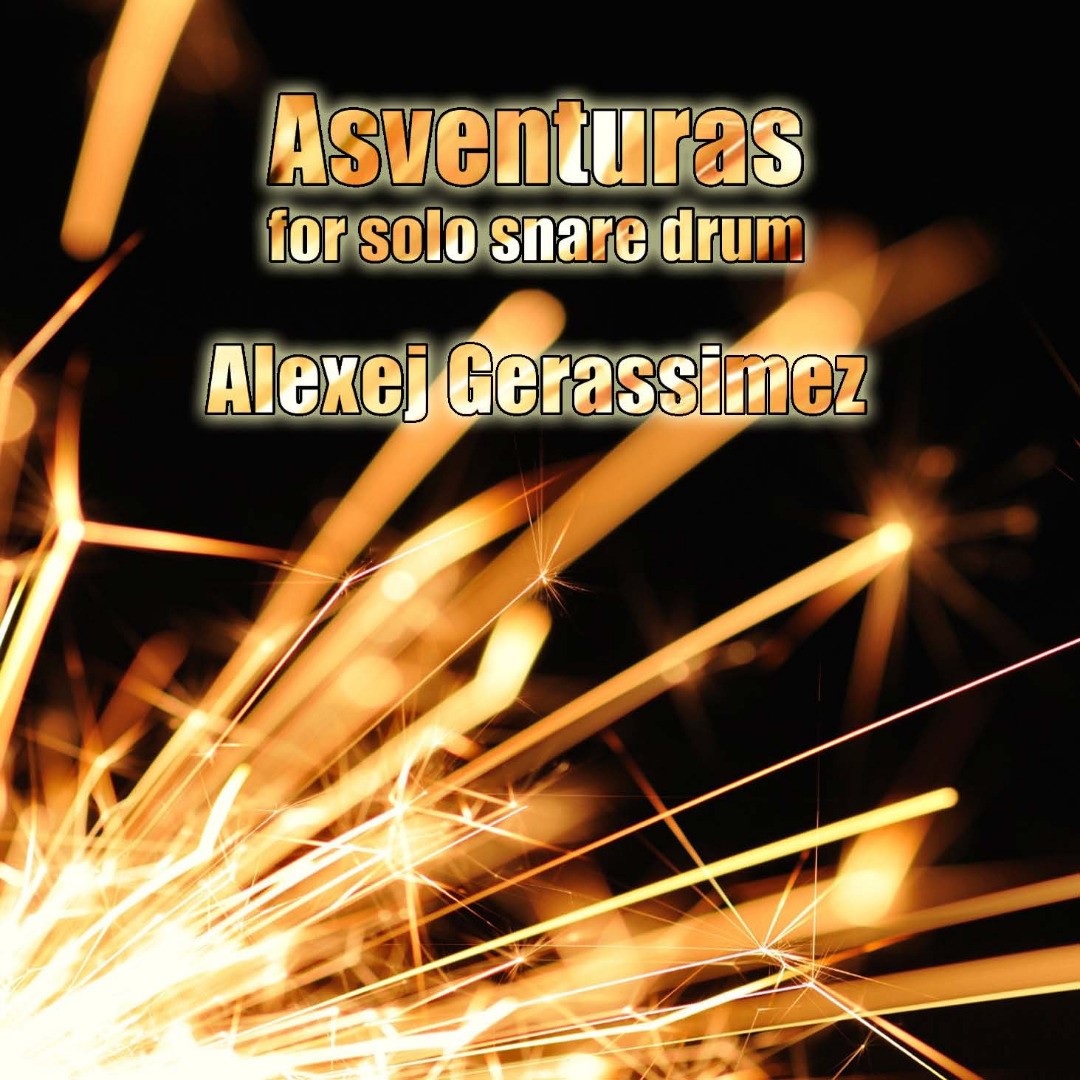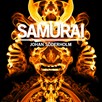
6&8
Composer: Tobias Broström
Instrument: Multi Percussion
Level: unknown
Published: 2007
Price: €17.00
Item details
-
Description +
-
Duration: 4 min.
6&8 borrows most of its material from West African drum traditions, in particular from Gambia. In 2001 I spent three weeks in the small village Tumani Tenda, and at the organized village-camp I had the opportunity to meet representatives from four distinct West African/Gambian musical cultures: Mandinka (cora, ballafon), Wollof (drums/singing), Susu (djembeh, dundun-bah, singing and dance), and Fula (flute, callabash, riti, and acrobatics).
Susu and Wollof, which both share a strong tradition in drumming, were my primary inspirations. Susu is originally from Guinea Conacry and is closely related to Mandinka. All of these once disparate cultures are now found all over West Africa due to the circulatory effects of war, tourism, trade and nomadism. Susu was refined under the administration of president Sechko Touray in Guinea Conacry when music schools for all children were established.
The rhythms in 6&8 are traditional beats and breaks (particularly in the style of Susu), here developed and modernized. Call and reply, for instance, is characteristic of Wollof -originally a way of communication, they are the messengers and storytellers. In 6&8 the bass drum imitates the DunDun-Bah (the Susu bass drum) and the hi-hat acts as a simplified clave usually played on a bell that is connected to the DunDun-Bah.
-
-
Instrumentation +
-
Multi Percussion:
Snare Drum
Hi-Hat
Bass Drum
-
-
Watch+
-
Other YouTube Performances:
Craig Bitterman
-
-
About the composer +
-
Tobias Broström was born in 1978 in Helsingborg, Sweden. Following four years of percussion studies at the Malmö Academy of Music, he embarked on the pursuit of a Master’s degree in composition, studying with the Swedish composer Rolf Martinsson and the Italian composer Luca Francesconi.
Broström has composed chamber opera and various chamber music, but during the last years he has mainly focused on orchestral writing in works such as La Danse, Transit Underground, Crimson Skies, Crimson Seas, Kaléidoscope, Violin Concerto, Arena – Percussion Concerto No. 1, Piano Concerto – Belle Epoque, Samsara, Cello Concerto and Lucernaris – Concerto for Trumpet, Live Electronics & Orchestra, which was composed for Håkan Hardenberger. Numerous soloists, conductors, ensembles and orchestras, including, Robin Ticciati, Michael Sanderling, John Storgårds, Anna Larsson, Karen Gomyo, Thomas Søndergård, Andrew Manze, Dima Slobodeniouk, Johannes Gustavsson, Per Tengstrand, Colin Currie, Mats Rondin, Tõnu Kaljuste, Simon Preston, Johan Bridger, Hugo Ticciati, Jaime Martín, BBC Symphony, Detroit Symphony, Dresdner Philharmonie, BBC Philharmonic, Komische Oper Berlin, Symphonieorchester des Bayerischen Rundfunks, Estonian National Orchestra, BBC Scottish Symphony Orchestra, BBC Wales, Gävle SO, Helsingborg SO, Trondheim SO, Malmö SO, Sinfonieorchester St. Gallen, Vogtland Philharmonie, Oviedo SO, NorrlandsOperans SO, Aurora Chamber Orchestra, Brooklyn Rider, Musica Vitae, Third Coast Percussion Quartet, Malleus Incus, Essens:1 and Gageego have performed his works. Tobias’ music have been performed throughout Europe, the USA and Asia.
Between 2006 – 2009 Tobias was Composer-in-Residence with the Gävle Symphony Orchestra under principal conductor Robin Ticciati, resulting in two new orchestral works each year. Two of these, Crimson Seas & Lucernaris were selected by Swedish Radio to represent Sweden in the European Broadcasting Union’s International Rostrum of Composers in 2007 & 2009. In autumn 2008 his Arena – Solo Version was picked out to be performed at the 52nd International Festival of Contemporary Music at the Venice Biennale and his orchestral piece Transit Underground was nominated for best orchestral piece of the year by Swedish Music Publishers’ Association. In 2010 Lucernaris was nominated for best orchestral piece and in 2012 La Danse was nominated.
-
-
Reviews +
-
Review (Percussive Notes, September (61) 2012)
With rhythmic influences of West African/Gambian music and single, diddle, and flam patterns on the snare drum, “6&8” is a “Three Camps”-meets-West Africa drumset solo. The performer plays the traditional djun-djun/bell patterns on bass drum and hi-hat while playing snare drum patterns primarily influenced by the Susu and Wollof drumming traditions.
The first section of the piece is comprised of rolls, eighth-note accent patterns with sixteenth-note diddles, downbeat bell (hi-hat) patterns, and cross-rhythm djun-djun (bass drum) patterns. The middle section is dominated by duplets and quadruplets with interesting accented hemiola implications. The final section begins at a faster tempo through the metric modulation of the quadruplet sixteenth note marked equal to the sixteenth note. The piece ends with an exciting accelerando to the final four bars marked “as fast as possible.”
“6&8” provides an opportunity for the student/performer to become familiar with the rhythms of the West African tradition while coordinating hands and feet in a work that will be interesting to listener and performer alike. It is suitable for advanced high school and college student study and seminar/recital performance.
—Susan Martin Tariq
-
-
Credits +
-
Front cover artist: Ronni Kot Wenzell
Printed in Copenhagen, Denmark
Copyright © Edition Svitzer
-




